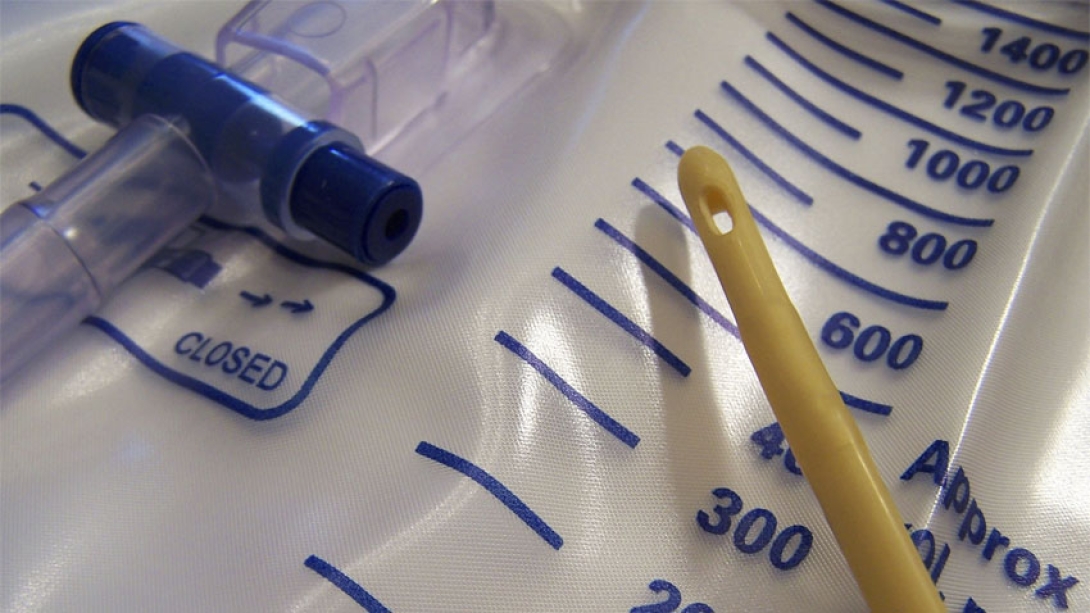Catheter-associated urinary tract infections drop in general hospital populations after teams get training, checklists and data, a new study finds.
5:00 PM
Author |
Right now, about one in five hospital patients has a catheter collecting urine, increasing the risk of a painful and potentially dangerous urinary tract infection, or UTI.
Many of these patients may not actually need a catheter. And none need an infection. But both catheter use and UTI rates have stayed high despite years of national attention on the issue.
Now, new results from a large national effort show that it may be possible to both reduce catheter use and UTIs at the same time, saving money and suffering.
The findings come from a concerted effort in 603 hospitals that included training and tools for doctors and nurses, and told them how their hospital units were doing.
By the end of the 18-month program, UTI rates among hospital patients in general wards had dropped by a third. Catheter use had dropped, too. Intensive-care patients didn't see a drop in either measure, however, suggesting that more work remains.
During the same time as the program, hospital-acquired UTI rates rose nationwide.
The results are published in the New England Journal of Medicine. The Agency for Healthcare Research and Quality funded the large national team, which the Health Research and Educational Trust, an affiliate of the American Hospital Association, coordinated. The data come from the first phase of the Comprehensive Unit-based Safety Program to reduce catheter-associated UTIs, also called On the CUSP: Stop CAUTI.

Technical and cultural change
The paper's first author, Sanjay Saint, M.D., MPH, calls the results encouraging.
"This program, in more than 10 percent of U.S. hospitals, shows we can make a difference in catheter-associated UTI rates and the use of catheters by addressing both technical and cultural aspects of health care," he says. "There's more work to be done, but all involved in this effort should take pride in knowing they helped move the needle on this important issue."
Saint, who is the George Dock Professor of internal medicine at the University of Michigan Medical School and chief of medicine at the VA Ann Arbor Healthcare System, has studied catheter use and UTI prevention in hospital patients for two decades.
Based on that research, he and his colleagues helped develop and implement the toolkit used in the Stop CAUTI national effort. This included using tools and processes initially tested in hospitals across Michigan, through the Michigan Hospital Association's Keystone Center for Patient Safety & Quality initiative.
Called the "bladder bundle," it combines protocols, checklists, training modules and data-sharing practices that teams can tailor for their hospital unit.
The tools encourage:
-
Daily checks on patients who have a catheter and whether they need it
-
Less indwelling catheter use, by using other urine collection means
-
Training on urinary management for all care team members
-
Regular use of infection-prevention techniques for catheter placement and maintenance
-
Feedback to doctors and nurses about their unit's catheter use and UTI rates
Coaching calls from regional leaders to share best practices and data
More about the findings
The paper analyzed data from 2011 to 2013 from 926 ICU and non-ICU hospital units in 32 states, the District of Columbia and Puerto Rico. Participation was voluntary. Nearly 60 percent of the units that took part were non-ICU medical and surgical wards.
The analysis revealed that:
-
The rate of catheter-associated UTIs dropped from 2.40 per 1,000 days of catheter use to 2.05, after differences in patients and hospitals were taken into account, a 14 percent overall drop.
-
Much of the total decline was due to changes in infection rates in non-ICUs, which went from 2.28 to 1.54 infections per 1,000 catheter-days — a drop of 32 percent.
-
In non-ICUs, the overall use of catheters went down from 20.1 to 18.8 percent of patients.
-
ICUs didn't see a substantial change in either measure, likely because the nature of patients treated in ICUs means more frequent monitoring and culturing of urine, so UTIs are more likely to be spotted.
-
There was no difference in UTI rates and catheter use between hospitals that completed the program and those that ended data collection early.
Any hospital can now access the toolkit used in the study, via the AHRQ website. Meanwhile, AHRQ, the Health Research and Educational Trust and U-M continue to analyze more data from On the CUSP: Stop CAUTI participating hospitals, including a number of emergency departments that joined for the second phase.
A new effort is extending to long-term care settings, where less is known about how to bring down catheter use and UTI rates. The experience in acute care settings should help with implementation in skilled nursing facilities and other long-term settings, says Saint's colleague, researcher Sarah Krein, Ph.D., R.N.

Explore a variety of healthcare news & stories by visiting the Health Lab home page for more articles.

Department of Communication at Michigan Medicine
Want top health & research news weekly? Sign up for Health Lab’s newsletters today!





